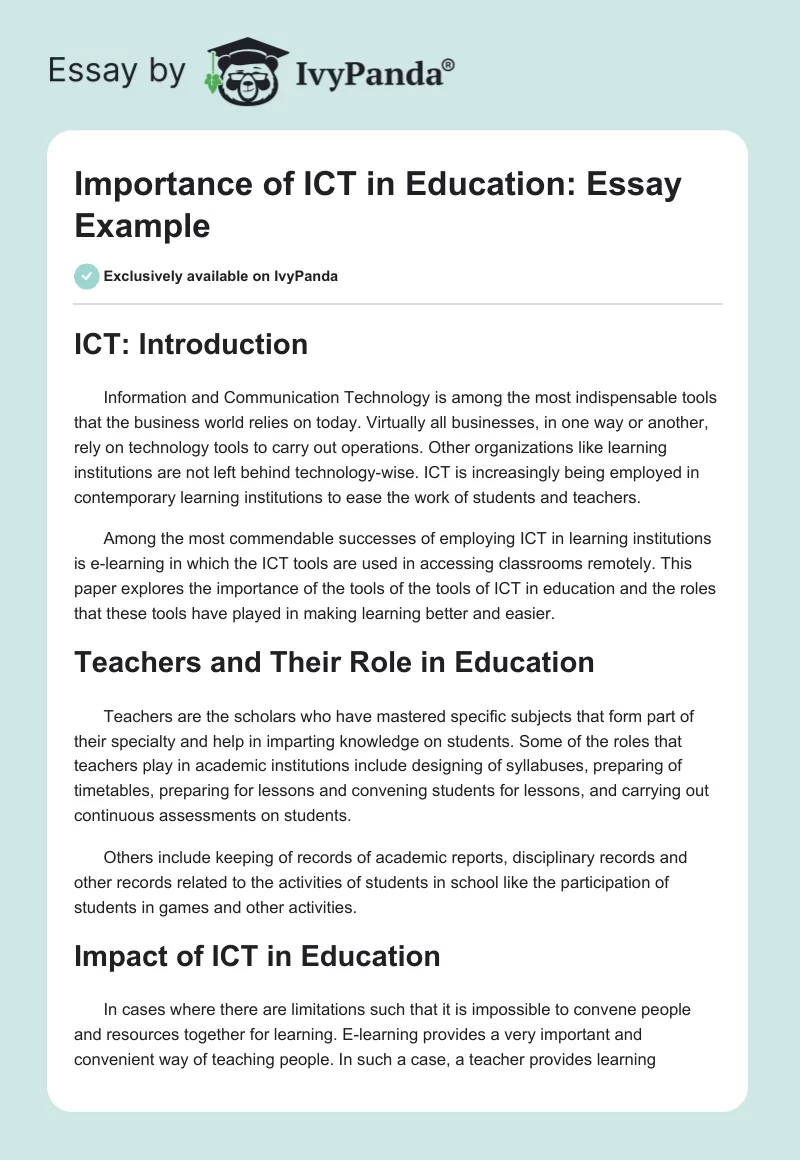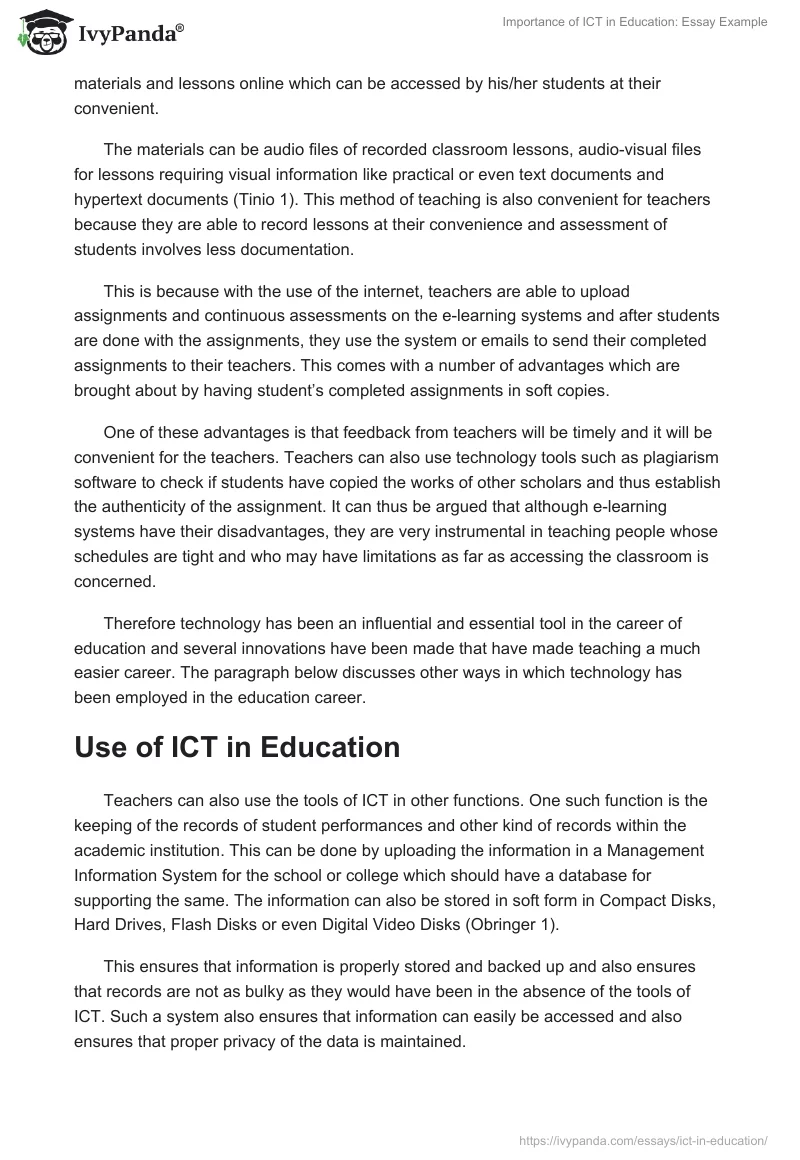ICT: Introduction
Information and Communication Technology is among the most indispensable tools that the business world relies on today. Virtually all businesses, in one way or another, rely on technology tools to carry out operations. Other organizations like learning institutions are not left behind technology-wise. ICT is increasingly being employed in contemporary learning institutions to ease the work of students and teachers.
Among the most commendable successes of employing ICT in learning institutions is e-learning, in which the ICT tools are used to access classrooms remotely. This paper explores the importance of the tools of the tools of ICT in education and the roles that these tools have played in making learning better and easier.
Teachers and Their Role in Education
Teachers are scholars who have mastered specific subjects that form part of their specialty and help in imparting knowledge to students. Some of the roles that teachers play in academic institutions include designing syllabuses, preparing timetables, preparing for lessons and convening students for lessons, and carrying out continuous assessments on students.
Others include keeping records of academic reports, disciplinary records, and other records related to the activities of students in school, like the participation of students in games and other activities.
Impact of ICT in Education
In cases where there are limitations such that it is impossible to convene people and resources together for learning. E-learning provides a very important and convenient way of teaching people. In such a case, a teacher provides learning materials and lessons online, which can be accessed by his/her students at their convenience.
The materials can be audio files of recorded classroom lessons, audio-visual files for lessons requiring visual information like practical or even text documents, and hypertext documents (Tinio 1). This method of teaching is also convenient for teachers because they are able to record lessons at their convenience, and the assessment of students involves less documentation.
This is because with the use of the internet, teachers are able to upload assignments and continuous assessments on the e-learning systems, and after students are done with the assignments, they use the system or emails to send their completed assignments to their teachers. This comes with a number of advantages which are brought about by having students complete assignments in soft copies.
One of these advantages is that feedback from teachers will be timely and it will be convenient for the teachers. Teachers can also use technology tools such as plagiarism software to check if students have copied the works of other scholars and thus establish the authenticity of the assignment. It can thus be argued that although e-learning systems have their disadvantages, they are very instrumental in teaching people whose schedules are tight and who may have limitations as far as accessing the classroom is concerned.
Therefore technology has been an influential and essential tool in the career of education, and several innovations have been made that have made teaching a much easier career. The paragraph below discusses other ways in which technology has been employed in the education career.
Use of ICT in Education
Teachers can also use the tools of ICT in other functions. One such function is keeping records of student performances and other kinds of records within the academic institution. This can be done by uploading the information to a Management Information System for the school or college, which should have a database for supporting the same. The information can also be stored in soft form in Compact Disks, Hard Drives, Flash Disks, or even Digital Video Disks (Obringer 1).
This ensures that information is properly stored and backed up and also ensures that records are not as bulky as they would have been in the absence of the tools of ICT. Such a system also ensures that information can easily be accessed and also ensures that proper privacy of the data is maintained.
Another way in which teachers can use the tools of ICT to ease their work is by employing tools like projectors for presentations of lessons, iPads for students, computers connected to the internet for communicating to students about continuous assessments, and the like (Higgins 1). This way, the teacher will be able to reduce the paperwork that he /she uses in his/her work, and this is bound to make his/her work easier.
For instance, if the teacher can access a projector, he/she can prepare a presentation of a lesson for his/her students, and this way, he will not have to carry textbooks, notebooks, and the like to the classroom for the lesson. The teacher can also post notes and relevant texts for a given course on the information system for the school or on an interactive website, and thus he/she will have more time for discussions during lessons.
Teachers can also, in consultation with IT specialists, develop real-time systems where students can answer questions related woo what they have learned in class and get automated results through the system (Masie 1).
Importance of ICT to Students
This will help the students understand the concepts taught in class better, and this way, teachers will have less workload. Such websites will also help teachers to show the students how questions related to their specialty are framed early enough so that students can concentrate on knowledge acquisition during class hours.
This is as opposed to a case where the students remain clueless about the kind of questions they expect in exams and spend most of their time preparing for exams rather than reading extensively to acquire knowledge. ICT can also be sued by teachers to advertise the kind of services they offer in schools and also advertise the books and journals they have written. This can be achieved by using websites for the school or specific teachers or professors.
Conclusion
As evidenced in the discussion above, ICT is a very instrumental tool in education as a career. The specific tools of ICT used in education, as discussed above, include the use of ICT in distance learning, storage of student performance and other relevant information in databases and storage media, and the use of tools of ICT in classroom like projectors, iPads and the like. Since the invention of the internet and the subsequent popularity of computers, a lot of functions of education as a career have been made simpler.
These include the administration of continuous assessments, marking continuous assessments, giving feedback to students, and even checking the originality of the ideas expressed in the assignments and examinations. All in all, the impact that ICT has had in educational institutions is so much that school life without ICT is somehow impossible for people who are accustomed to using ICT.
Works Cited
Higgins, Steve. “Does ICT improve learning and teaching in schools”. 2007. Web.
Masie, Shank. “What is electronic learning?” 2007. Web.
Obringer, Ann. “How E-Learning Works”. 2008. Web.
Tinio, Victoria. “ICT in Education”. 2008. Web.


